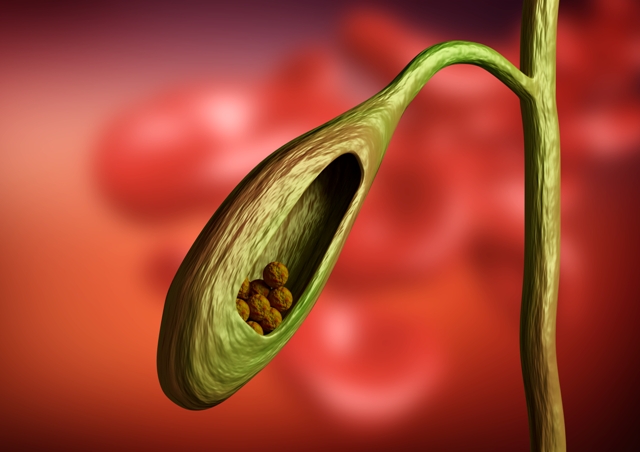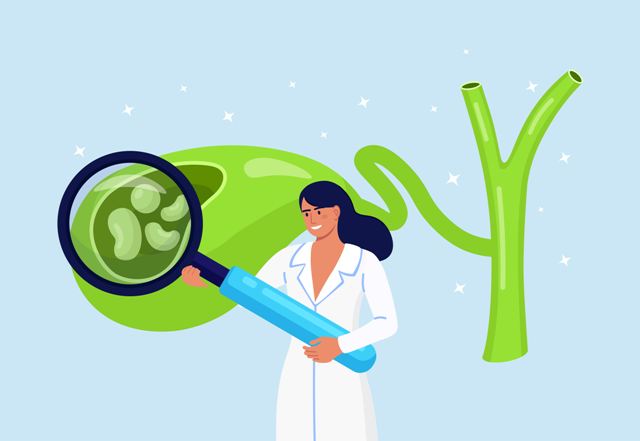Gallbladder is a small sac like organ attached to the right side of the undersurface of liver. It is an important organ of our body. The main function of gallbladder is to store and concentrate bile. Basically liver produces bile, which is then stored into gallbladder and gallbladder releases bile during fat digestion.
Body requires bile for fat digestion. Bile helps in emulsifying fat molecules, which ultimately aids in enhancing the surface area of fat molecules thus makes them more accessible to the digestive enzymes hence facilitates fat digestion
When an individual consume fat then his or her gallbladder begins to contract and pushes the stored bile into a tube named common bile duct, which carries it into small intestine where bile helps with digestion
Type of gallbladder disease
Gallbladder diseases are referred as those diseases that affect the gallbladder
Below points will provide an overview of different types of gallbladder diseases –
- Bile is composed of cholesterol, fat, protein, water, bile pigments and bile salts. If bile contains too much cholesterol and pigments, then under such condition they subsequently accumulated within gallbladder and form stones. This type of stone is termed as gall stones.
- Two types of stones are formed within gallbladder, such as cholesterol stone and pigment stone. Cholesterol stones are basically yellow green coloured stone formed by cholesterol. Excessive cholesterol in bile hardened into cholesterol stone. Whereas pigment stones are small and dark coloured stones prepared by bile pigments especially by bilirubin

Types of biliary tract diseases
The duct that makes, stores and releases bile into small intestine is known as biliary duct. Various individual suffer from gallbladder and biliary tract disorders. Though the disorders of gallbladder and biliary tract are closely related but the most common disorder of biliary tract are recognized as cholelithiasis, choledocholothiasis and cholecystitis
Cholelithiasis
- In this condition gallstones are formed within gallbladder but the gallbladder is not infected
- It does not show any symptoms thus in most of the cases patients are unaware about the presence of stones

Choledocholothiasis
- It is a condition, which is caused when gallstones slip into the bile duct thus causes obstruction in bile flow
- It is also responsible for developing severe pain as well as cramping
Cholecystitis
- It is referred as gallbladder inflammation
- When gallstones obstruct the bile ducts then it causes a back flow of bile as a result the wall of the gallbladder becomes inflamed as well as distended
- Infection can also occur
- Patients may experience severe abdominal pain along with nausea, vomiting and flatulence
- In severe condition jaundice may also occur

Risk factors associated with enhancing the prevalence of gallstone formation and biliary tract disorders
Below listed factors are responsible for increasing the susceptibility of respective diseases –
- Hypercholesterolemia
- Obesity
- High fat intake
- Family history
- Gender (females are more prone to develop gallbladder and biliary tract disorders)
- Older age
- Diabetes mellitus
- Trunkal body fat distribution
- Inflammatory bowel disease
- Biliary sludge
- Excessive consumption of oral contraceptives
- Biliary tract infection
- Cirrhosis
- Alcoholism
Nutritional management
Cholecystectomy has been traditionally used as a remedial action for gallbladder and biliary tract diseases. Basically it is the removal of gallbladder by using traditional laparotomy. Recently shock wave lithotripsy is widely used for this purpose
Apart from medicinal treatment or surgical therapy, nutrition also plays vital role in treating gallbladder and biliary tract disorders. Proper nutritional support not only helps in improving the symptoms but also plays vital role in decreasing the susceptibility of developing these disorders. Below points will provide an outline of the dietary considerations for the management of gallbladder and biliary tract disorders –
Energy
- It is better to consume quite lesser amount of energy than the normal recommendation
- The calorie should come from complex carbohydrates

Carbohydrates
- 60% of daily calorie should come from carbohydrates but it is better to focus on the consumption of complex carbohydrates as they are the rich sources of fibres
- Consumption of refined carbohydrates and simple sugar should be strictly avoided as they may increase the prevalence of cholesterol saturation as well as lithogenicity of the bile (cholesterol precipitation within bile), which ultimately increases the risk of developing gallstones
- Fibre also plays important role in decreasing the concentration of cholesterol within body thus it helps in reducing the susceptibility of developing gall stones and biliary tract disorders as well
- Soluble fibre is associated with improving the growth of beneficial gut microflora, which helps to inhibit the production of endogenous cholesterol

Proteins
- Protein should be consumed as per RDA
- It is better to focus on plant protein consumption because too much consumption of animal proteins may worsen the condition as animal proteins contain fats and they are also lithogenic (stone forming) in nature compared to plant proteins
- Diet should contain pulses, legumes, lentils, seeds, beans as they are good sources of plant proteins and help in reducing the severity of the condition by making the body able to getting rid of bile acid sterols out of the gut
- In the case of animal protein, an individual can consume low fat milk or skimmed milk, egg white or chicken

Fats
- It is better to consume a fat restricted diet because the main aim of the treatment should be focused on reducing the discomfort
- It is better to keep the gallbladder at rest condition and the contraction of gallbladder should also be minimized and it can easily achieved by consuming less fat
- Whereas excessive fat consumption is also accountable for increasing the risk of hypercholesterolemia that is considered as one of the leading causes of gallstone formation
- 20 to 30 g of fat should be consumed daily
- Consumption of saturated fat and Trans fat should be strictly avoided
- All the fats should come from plant sources as plant fat contains adequate amount of unsaturated fatty acids, which are responsible for decreasing the concentration of cholesterol especially the bad cholesterol or LDL in body that ultimately helps in reducing the susceptibility of developing gallbladder and biliary tract disorders
- On the other hand unsaturated fat especially MUFA helps in increasing the ratio of HDL to LDL thus plays vital role in reducing the prevalence of gallstone formation
Vitamins and minerals
- All the vitamins and minerals should be consumed as per RDA and special consideration should be given on the intake of fat soluble vitamins as fat mal-absorption of fat is suspected in this condition
- Vitamin C is also very beneficial in this condition as it helps to reduce the risk of developing infections and also promotes healing
- Diet should contain plenty of fruits and vegetables as they provide abundant vitamins and minerals

Foods that should be included and excluded from the diet of a patient with gallbladder and biliary tract disease
Below listed table will give an overview of foods that should be included and excluded from diet –
|
Foods included |
Foods excluded |
|
|
The above stated nutritional guidelines are extremely useful for treating gallbladder and biliary tract disorders


Source:
Allen, S.N., 2013. Gallbladder disease: Pathophysiology, diagnosis, and treatment. US Pharm, 38(3), pp.33-41.
Bansal, A., Akhtar, M. and Bansal, A.K., 2016. A clinical study: prevalence and management of cholelithiasis. International Surgery Journal, 1(3), pp.134-139.
Curry, M.P. and Hegarty, J.E., 2005. The gallbladder and biliary tract in cystic fibrosis. Current gastroenterology reports, 7(2), pp.147-153.
Johansen, L. and McKiernan, P., 2016. Management of biliary tract problems. Paediatrics and Child Health, 26(6), pp.261-266.
Lammert, F., Gurusamy, K., Ko, C.W., Miquel, J.F., Méndez-Sánchez, N., Portincasa, P., Van Erpecum, K.J., Van Laarhoven, C.J. and Wang, D.Q.H., 2016. Gallstones. Nature reviews Disease primers, 2(1), pp.1-17.
Larsson, S.C., Håkansson, N. and Wolk, A., 2017. Healthy dietary patterns and incidence of biliary tract and gallbladder cancer in a prospective study of women and men. European Journal of Cancer, 70, pp.42-47.


